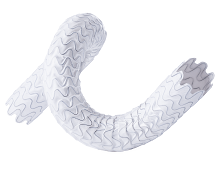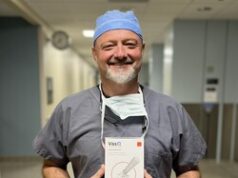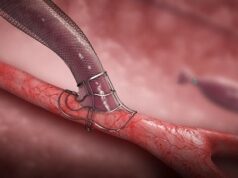
Twelve-month results from a first-in-human study of the Wrapsody cell-impermeable endoprosthesis (Merit Medical Systems) for the treatment of access circuit stenosis in haemodialysis patients are “very encouraging”. This is according to James Gilbert, a consultant transplant and vascular access surgeon at the Oxford University Hospitals NHS Foundation Trust in Oxford, UK, and president of the Vascular Access Society of Britain & Ireland (VASBI), who presented these data for the first time at the Cardiovascular and Interventional Radiological Society of Europe 2021 summit (CIRSE; 25–28 September, virtual).
Gilbert noted that this first-in-human study—dubbed WRAPSODY FIRST—produced positive results in terms of safety, detailing that no adverse events confirmed as being device-related were observed in 39 patients at one-year follow-up. Regarding effectiveness, he reported promising target lesion primary patency (TLPP) rates at 12 months across all lesion sites, in line with the study’s six-month data, and stated that access circuit patency rates also appear to remain high following treatment with the device. Gilbert went on to detail the pivotal WRAPSODY WAVE trial—a global randomised controlled trial (RCT) that is currently underway to assess the Wrapsody endoprosthesis.
Speaking to Renal Interventions, Gilbert said: “The 12-month effectiveness data, particularly of TLPP, are very exciting because we may have a stent that requires fewer reinterventions to maintain patency at the lesion site and, more importantly, ensures that the access circuit remains functional—which is key for any dialysis patient. The data were also reproducible at all lesion sites treated within the access circuit, from the cephalic arch in a brachiocephalic AVF [arteriovenous fistula] to the graft vein anastomosis site and the central veins. This is suggestive that there is something about the stent’s design, with its cell impermeable middle layer and softened end rows, that is key in minimising edge stenosis at both ends of the stent.
“We recognise that these very encouraging data are only from a small, first-in-human study and so the WRAPSODY WAVE trial will be key in confirming just how good this stent can be. The WAVE study will not only provide a bigger number of patients in which to assess the effectiveness of the stent, it will also provide experiences from a range of expert clinicians globally.”
Addressing the CIRSE audience, Gilbert described the Wrapsody endoprosthesis as a “unique, tri-layered stent graft” that is currently CE-marked for use in Europe and is available in sizes ranging from 6mm to 16mm, making it a viable treatment option for a “huge range” stenotic lesions, including those in the peripheral and central veins of an access circuit.

Gilbert went on to detail the design and purpose of WRAPSODY FIRST—a prospective, three-centre, single-arm, first-in-human feasibility study assessing the safety and effectiveness of the device, for which he is the primary investigator. The subject population consisted of dialysis patients with AVFs or arteriovenous grafts (AVGs) in their upper limbs, who experienced stenosis or occlusion within their access circuit. Gilbert reported the primary safety objective as being the proportion of patients without any localised or systemic safety events affecting the access or venous outflow circuit, and resulting in surgery, hospitalisation, or death, while the primary effectiveness objective was TLPP. Follow-up took place at 30 days, three months, six months and 12 months, he added.
Gilbert stated that a total of 46 patients (24 female, mean age=66.7 years) were enrolled in the study, with a cumulative access loss of five patients at the 12-month follow-up point, as well as a further two patients undergoing transplantation, leading to outcome data for 39 patients being available beyond one year. On safety outcomes at 12 months, he reported a total of five adverse events, four of which were adjudicated as being procedure-related, with the access circuit not being salvaged and a lack of imaging data making it impossible to determine if the one remaining event—a thrombosed fistula—was device- or procedure-related.
Touching on effectiveness next, Gilbert described the 12-month TLPP rate of 84.6% as “very encouraging”, and similarly positive to the 97.7% TLPP rate seen at six months, before reporting that reintervention was successful in all problematic cases—resulting in a 12-month assisted TLPP rate of 100%. Further, he noted an access circuit primary patency rate of 65.9% at 12 months. All but five of the remaining access circuits were salvaged via reintervention, he added, leading to a secondary patency rate of 88.6%. These data are also published in the journal CardioVascular and Interventional Radiology (CVIR).
Gilbert concluded his presentation by conveying details of the WRAPSODY WAVE trial, which is a multicentre RCT designed to further assess the Wrapsody endoprosthesis as a treatment option for dialysis access circuit stenoses and support US Food and Drug Administration (FDA) approval of the device. This trial is already underway, and will involve 1:1 randomisation of patients across two study arms—Wrapsody versus percutaneous balloon angioplasty (PTA) in AVF peripheral circuit stenosis (244 patients), and Wrapsody versus PTA in central vein stenosis of AVF and AVG circuits (120 patients)—in addition to a third, registry-based arm that will assess the device’s use at the graft-vein anastomotic site in 113 patients.













